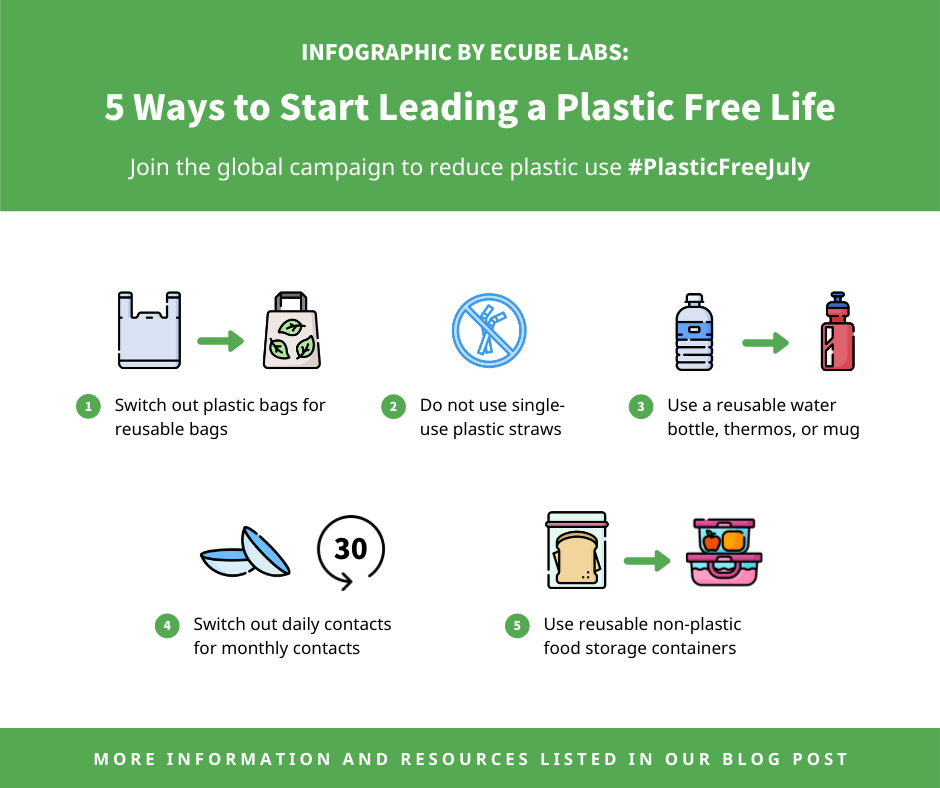In honor of Plastic Free July, we wanted to highlight and provide a few simple and easy changes you can make in your everyday life to reduce plastic use. To help you better understand why there is a month dedicated to eliminating single-use plastic, these are some quick statistics of the negative impact plastic has on the environment. In honor of Plastic Free July, we wanted to highlight and provide a few simple and easy changes you can make in your everyday life to reduce plastic use. To help you better understand why there is a month dedicated to eliminating single-use plastic, these are some quick statistics of the negative impact plastic has on the environment.
According to National Geographic, nearly 1,000,000 plastic bottles are sold every minute around the world while 100 trillion plastic bags are used worldwide every year. Given the statistic that more than 40% of plastic that is produced is used only once and thrown away, we can conclude most of these plastics end up in landfills or in nature. It is important to note that because plastic is not biodegradable, they do not disappear from Earth after a certain amount of time. Actually, plastic gets broken down into smaller pieces that end up in our drinking water and food supply (more bad news: this process may take forever depending on the kind of plastic). If you ever had worries about drinking water from an overheated plastic bottle because of the chemicals that may have leaked from the plastic, imagine the short and long term effects of accumulated plastic in nature and our human bodies.
Hopefully now that you have a better idea as to how harmful plastic is for the environment, we can jump into why Plastic Free July was established. Inspired by the mission to “build a global movement that dramatically reduces plastic use and improves recycling,” The Plastic Free Foundation started Plastic Free July in 2011 and has since won awards for its efforts and results. According to their 2019 annual report, 250 million people had participated in the campaign which resulted in the reduction of approximately 825 million kg of plastic that would have been used. The campaign encourages people to avoid using at least one single-use plastic item as a baby step to leading a plastic-free lifestyle.
Below are 5 ways you can participate in Plastic Free July:
1. Switch out plastic bags for reusable bags
The next time you are out on a grocery run, bring along a backpack, canvas bag, or even a purse (depending on how much you need to buy). Not only are you helping to save the planet, you will also be saving money since many areas of the world are now charging customers for using plastic bags. With supermarkets and stores almost always selling reusable totes, think of it as a long term investment that benefits the environment. Click here to read a in-depth breakdown of how plastic bags are harmful.
2. Do not use single-use plastic straws
While the best solution would be to not use straws at all, we understand that there may be circumstances where the use of straws is unavoidable, especially for those with disabilities. Nowadays, there are many eco-friendly alternatives that include compostable paper straws and reusable metal straws. Although these straws may not be the perfect, all-in-one solution since they may be disposed of incorrectly or cause bodily harm, they do produce a smaller carbon footprint during the production process which is a win for the environment.
3. Use a reusable water bottle, thermos, or mug
This option is probably the most popular. Besides having another surface that you can fill with stickers as a form of self expression, reusable water bottles are great for drinks on the go, especially if they are made with materials that keep your drink at the optimal temperature. This also means you do not have to worry about the chemical from plastic that may leak into your water. Fun fact: Some coffee shops will offer you a discount if you bring your own cup/thermos/mug.
4. Switch out daily contacts for monthly contacts
For those wearing contacts, whether prescription or colored lenses, the daily option is often the popular choice given that you do not need to worry about cleaning the lenses for multiple uses. When these contacts are disposed of, they are oftentimes flushed down the drain or thrown in the garbage. Because many countries do not have a set disposal protocol, much less a recycling program dedicated to contacts lenses like the UK, the plastic in the packaging and contacts themselves are contaminating our water supply or accumulating in landfills. Although wearing glasses would be the best solution, opting for extended wear contacts is another option that reduces plastic consumption.
5. Use reusable non-plastic food storage containers
When packing food from home, stop worrying about whether you successfully sealed the sandwich bag and instead opt to use a microwave-safe food storage container that will allow you to reheat your food as needed. To take this practice to the next level, when you go out to eat and are not able to finish everything, pack the leftovers in your own food container.

Although this is not a comprehensive list of solutions, we want to help kickstart a conversation about the harm of single-use plastic and how we can reduce our plastic consumption. If you are looking for more ways to reduce plastic use in your everyday life, check out this blog post. Like with any movement or campaign, we hope that these changes to lead a plastic free lifestyle lasts for longer than the month of July. We all play a part in keeping the Earth clean and habitable, so let us do all we can for this planet we call home.
References:
- https://myplasticfreelife.com/plasticfreeguide/
- https://www.plasticfreejuly.org/
- https://www.plasticpollutioncoalition.org/
- https://www.huffpost.com/entry/compostable-straws-twist_n_5b460643e4b0c523e264f9a7#:~:text=One%20reason%20is%20that%20they,come%20from%20a%20renewable%20source.
- https://www.ourlaststraw.org
- https://www.nytimes.com/2019/07/11/world/europe/metal-straws-death.html
- https://www.nationalgeographic.com/magazines/l/plastic/social.html?beta=true&utm_source=Facebook&utm_medium=SocialAds&utm_content=link_fbp20180517ngm-plasticssubscriptions&utm_campaign=Content&kwp_0=814963&kwp_4=2796431&kwp_1=1187183
- https://www.plasticfreejuly.org/wp-content/uploads/2020/01/PFJ-Annual-Report-2019-screen-spreads.pdf
- https://www.theguardian.com/environment/2019/jan/15/uks-first-contact-lens-recycling-scheme-launches
